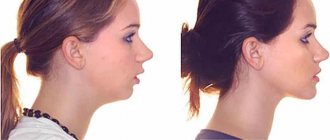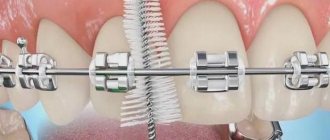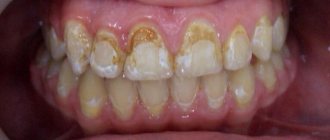What do we mean by sparse teeth?
Scientific terms that describe sparse teeth or spaces between teeth are diastema and trema . The diastema is the space between the central incisors, and the trema is the space between the other teeth. These terms are practically not used by patients. Usually they go to the dentist, describing this problem using expressions such as: sparse teeth, space between teeth, dental gaps, spaces between teeth, or I want neat, straight teeth. In this article we will talk about any dental space that concerns you aesthetically.
Sealing
Currently, it is one of the most affordable ways to treat rare teeth. Its wide distribution is due to its low cost and ease of implementation.
The essence of the method is as follows: fillings of the same color as the natural chewing units are applied to the teeth. The procedure is considered a jewelry procedure, since the doctor must literally mold new bone structures. As a result, the teeth become wider and the gaps between them disappear. Only a specialist can visually distinguish fillings from natural dental units.
During the procedure, orthodontists use only high-quality materials. These are ceramics and porcelain.
After filling rare teeth, the functioning of the gastrointestinal tract is normalized and a correct bite begins to form.
Why do gaps appear between teeth?
This image shows a case of sparse teeth that is being resolved with dental veneers. Impressions were taken using a 3Shape Trios intraoral 3D impression scanner.
Dental spaces can interfere with the proper functioning of the chewing process, especially when the cause is acquired rather than natural. Before you close the gaps between your teeth, you need to know the factors that caused them to appear:
- Congenital factor
- Incorrect occlusion (uneven contact surfaces overload certain groups of teeth and, consequently, tremors occur)
- Some forms of dental anomalies (when teeth, usually the first premolars or lateral incisors, do not erupt into the dental arch)
- Migration of teeth after extraction
- Defective skills (when the tongue pushes the teeth forward with constant pressure)
- Pathology such as periodontitis or osteoporosis (bone loss leads to changes in the dentition)
Installation of a bridge
The use of fixed orthodontic structures is a modern way to fill wide gaps in the dentition.
In order for the prosthesis to be securely fixed, it is necessary to have supporting dental units. It is on them that the entire structure is attached.
The best option is to make a bridge from metal ceramics. The service life of this design is 7 years or more. At the same time, the bridge retains its original shade and does not differ from adjacent natural teeth.
Contraindications to installing a prosthesis on rare teeth:
- Acute periodontitis.
- Parafunctions of the masticatory muscles.
- Insufficient height of supporting teeth.
If there are absolute contraindications, the doctor makes a decision regarding the advisability of using a different treatment method.
Solutions: How can we close the gaps between teeth?
There are two ways to solve this problem:
- Braces (the most correct and useful solution for closing gaps, since it does not require tooth preparation (grinding)
- Veneers or ceramic dental crowns (solve the problem of sparse teeth, but also other unsightly aspects such as: shape, size, color, etc.)
The choice of solution for “sparse teeth” is directly related to the cause of the gaps. Each case with rare teeth necessarily requires an individual approach, since the solutions presented above have special indications and recommendations, sometimes even contraindications. Here are some of these exceptions:
| Braces | Ceramic veneers | None of them | Both solutions |
| If tooth gaps are the result of missing teeth and their migration, then the most appropriate option would be to choose braces. After straightening the teeth, it is recommended to fill the space left after the extraction with dental implants to prevent the teeth from migrating back. | When the cause of rare teeth is congenital, braces will not help, because the teeth are in their places, even if they are not aesthetically pleasing. In this case, the gaps between the teeth will be closed with dental veneers. | If you suffer from periodontitis, which has caused gaps between your teeth, then neither veneers nor braces may be an option. Read here how to solve this problem if the gaps between teeth are the result of periodontitis. | If your teeth are too short and the gaps between them are too short, it would be better to choose both solutions. Closing the gaps with veneers alone will make them appear square. If the gaps are closed only with braces, it will appear that they are even smaller. It is recommended to wear braces first and then apply dental veneers to lengthen them. |
Causes and consequences
The “culprit” of the pathology is a genetic factor. Large distances between chewing units are noticeable already at the stage of eruption of milk teeth. In extremely rare cases, pathology develops against the background of progression of dental diseases.
Rare teeth in humans are not only unsightly, but also dangerous to health. Initially, psycho-emotional instability appears. It is caused by complexes that have arisen and low self-esteem.
In addition, sparse teeth cause the following pathological conditions:
- Disorders of the gastrointestinal tract. Wide spaces between dental units do not allow for proper chewing of food. As a result, food enters the stomach in an insufficiently processed form. The natural consequence is indigestion.
- Tooth loss. Chewing units located far from each other are characterized by increased fragility. In addition, they are extremely vulnerable to any external influences.
- Inflammatory processes in the oral cavity. When there are large gaps between teeth, soft tissues also become more vulnerable to external influences. They are easily injured, and when pathogenic microorganisms penetrate the oral cavity, an inflammatory process develops.
To prevent the development of complications and make your smile perfect, you need to contact an orthodontist. Only a doctor can provide information on how to correct rare teeth in each specific case.
How much does a perfect smile without gaps between teeth cost?
A perfect smile without gaps requires, first of all, a lot of patience and a little trust. Material costs depend on your choice and on the country where you want to be treated. Non-EU countries widely practice dental tourism, offering very competitive prices.
Braces, for example, in our clinic are not at all expensive (from 550 euros to 750 euros), you need to come to Moldova for adjustments. This is why we recommend that you evaluate how rational or economical the entire treatment will be.
Ceramic veneers cost 225 euros per tooth. Their advantage is that the treatment is carried out in one stage, which makes it very attractive to people abroad. To prepare teeth for EMAX ceramic veneers, we use a microscope and other magnifying devices, which makes the preparation (grinding) imperceptible, but the end result will surprise you to tears.
Types of bite
The bite can be correct or incorrect. If it is correct, then it does not affect the condition of the teeth and health in general. The jaws close correctly, articulation is painless, and the temporomandibular joint moves smoothly. A person can chew food normally, which has a positive effect on digestion, the state of the gastrointestinal tract and well-being.
There are 4 types of physiological occlusion:
- straight,
- orthognathic,
- physiological prognathia,
- opisthognathia.
Types of malocclusion:
- Distal. It is characterized by a large sagittal fissure - up to 9 millimeters. The teeth of the upper jaw protrude forward. More often, the appearance of the anomaly is influenced by genetic predisposition. But it can also be triggered by bad habits or untimely removal of baby teeth.
- Open. The jaws cannot be closed tightly because the side and front teeth do not touch. The pathology is often acquired.
- Deep. The upper jaw overlaps the lower jaw, so the teeth do not touch.
- Mesial. The lower jaw protrudes forward.
- Cross. The jaws do not close tightly, and the teeth grow incorrectly and are of different sizes.
- Edentia. With such a pathological bite, some of the teeth in the row are missing.
- Tremas and diastemas. The peculiarity is that the teeth are too sparsely spaced, causing large gaps to appear between them.
- Crowding. Teeth grow incorrectly and can “crawl” onto each other.
Each type of malocclusion requires specific treatment. An orthodontist will help you choose the right option after diagnosis.
Types of anomalies
- macrodentia: the anomaly is that the teeth are too large, often causes crowding of the row, affects the anterior region of the jaw,
- microdentia: excessively small teeth inevitably affect the aesthetic side of the issue. Most often, the defect affects the entire jaw, which is why wide gaps are formed in the rows,
- pointed crowns: wide at the gums and narrow at the apex, have a pointed tip resembling a spike,
- other anomalies of shape: in dental practice, there are a variety of variations of irregular teeth shape. Often it is simply impossible to clearly distinguish between them.
Correction of bite in adults: features and contraindications
Jaw defects cannot always be corrected during active tooth growth (up to 18 years of age). But treatment is possible even after 40 years. Bite correction in adults is carried out using the same methods as in children. But you will need to take into account that with age, body characteristics and contraindications appear.
Contraindications for bite correction:
- oncology,
- severe pathologies of the respiratory system,
- mental disorders,
- blood diseases,
- pathologies of the cardiovascular system,
- missing several teeth in a row,
- disruption or reduction in the process of bone tissue regeneration, the patient does not properly maintain oral hygiene.
Each case is unique, so the doctor’s task is to conduct a full diagnosis, select orthodontic plates, braces, aligners and trainers that will help solve the patient’s problem.
Methods for correcting bite
The methods used in dentistry to correct bites are divided into 2 groups - surgical and non-surgical.
Surgical methods
Surgical techniques are necessary if the patient is diagnosed with complex anomalies of the dentofacial apparatus, high crowding of teeth, or if treatment needs to be carried out quickly. The intervention is carried out under sterile conditions. For pain relief, both general anesthesia (if necessary, incisions of bone tissue) and local anesthesia (if necessary, incisions on the gums) are used.
The rehabilitation period after surgery is up to 3 weeks. After surgery on the bone tissue, the patient will need to develop the jaw. Additional braces may also be required.
Surgical techniques are only suitable for treating adults - when the jaw is already fully formed. In severe situations, tooth extraction and implantation may also be required.
Non-surgical methods
If, during the diagnosis, the doctor identified mild to moderate jaw pathologies in the patient, then correction of malocclusion in adults can be done without surgical intervention. For this, orthodontists use:
- bracket systems,
- orthodontic devices,
- trainers,
- veneers,
- crowns,
- mouth guards
The first option is often chosen, as it is the most effective.
Advantages and disadvantages of braces
Braces for the correction of malocclusions are chosen more often than other options. But this treatment method has its advantages and disadvantages that cannot be ignored.
Advantages:
- work effectively even with complex malocclusions and crowded teeth;
- the patient has the opportunity to choose a system that will correspond to his financial capabilities and wishes.
Flaws:
- at the stage of adaptation, the design may cause discomfort;
- it is necessary to carefully care for braces and follow a diet;
- the aesthetics of the smile may suffer (if you choose a metal structure);
- the risk of superficial caries formation increases.
Why is it important to correct malocclusion?
Correction of dental malocclusion can be carried out for both adults and children - there are no age restrictions. The problem cannot be left unattended.
Why do you need to correct dental anomalies:
- aesthetics improves;
- diction improves;
- facial muscles relax;
- the functioning of the temporomandibular joint improves;
- headaches associated with malocclusion disappear;
- the risk of developing diseases of the gums and teeth is reduced, as the pressure on the teeth is reduced, and the problem of enamel abrasion is solved.
Correcting the bite also helps to cope with psychological problems that were caused by pathology - isolation, secrecy, reluctance to communicate with other people.
Is it possible to correct an overbite without braces?
Correcting a bite with braces is the most effective method of coping with pathology, even in adults. But if the patient has only minor dental deformations, the use of such a design may not be necessary. Then removable systems, such as aligners and trainers, are better suited. Veneers will help improve the aesthetics of your smile.
Veneers and crowns
Veneers are thin ceramic overlays. They are fixed to the front surface of the teeth after preliminary grinding. Suitable for correcting small defects in the frontal area. They are more preferable than crowns, since they do not cover the entire tooth, but only its front surface.
Advantages:
- high aesthetics;
- efficiency;
- the ability to eliminate tremata, diastemas, slight reversal of incisors;
- the overlays are durable and do not stain;
- there is no need for bleaching - the color of the veneers can be matched to your own tooth tissue or the dentures can be made lighter.
But such prosthetics also have some disadvantages:
- you need to grind down your own tooth tissue (sometimes even remove the pulp);
- Ceramic onlays cannot correct serious bite defects.
Aligners
An aligner is a transparent silicone tray that is made individually for each patient. Treatment requires 2-3 such aligners with varying degrees of elasticity. You need to wear mouthguards night and day (22–24 hours a day). Removal is allowed during meals and for cleaning.
Aligners are suitable if you need to correct mild or moderate dental deformation.
Advantages:
- easy care - just regularly clean the aligner with a brush;
- there is no need to diet or avoid coloring foods;
- can be used for whitening.
Flaws:
- are not firmly fixed on the teeth;
- not suitable for the correction of severe malocclusions;
- the need for prolonged wearing.
Trainers
The trainer is a removable structure in the form of a splinting mouthguard. It is made of plastic. Designed for overnight wear and recommended for use several hours a day.
Advantages:
- can be used at the retention stage after orthodontic treatment;
- low price;
- Suitable for correcting malocclusion of baby teeth.
Flaws:
- trainers are not used to correct serious malocclusions;
- discomfort when wearing.
Orthodontic devices
Orthodontic devices are a plate with clasps (hooks), screws, rings and arches. All these parts ensure that the teeth move in the desired direction. The design can be either removable or non-removable.
Orthodontic appliances can correct mild to moderate malocclusions. But when worn, they cause discomfort and affect diction.
Correction of malocclusion begins with a consultation with an orthodontist and diagnostics, including an orthopantomogram, CT scan of the upper and lower jaw, taking impressions, etc. Based on the results, the doctor will determine the optimal correction options and announce the cost and timing of treatment.











